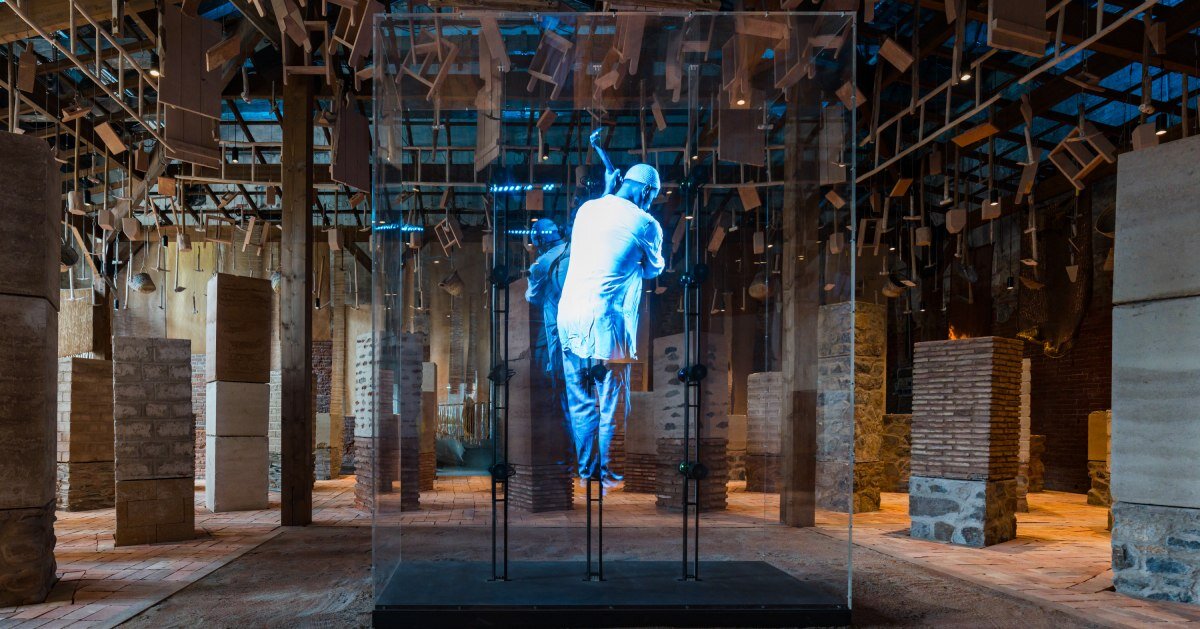Materiae Palimpsest: Morocco pavilion on craft & construction
At the 2025 Venice Architecture Biennale, Morocco’s national pavilion addresses challenges posed by earthquakes across the region by taking an elemental approach to material, memory, and seismic resilience. Titled Materiae Palimpsest, the exhibition takes form as an evocative landscape bridging construction research prototypes with an artistic scenography. We see a cluster of columns built from natural local materials such as rammed earth, stone, and timber sourced from across Morocco, configured as a series of passageways almost reminiscent of architectural ruins – perhaps the aftermath of an earthquake. They all encircle a hologram representing the human condition and ancestral knowledge — ‘It’s intentionally fragile and immaterial, confronting the physical nature of the materials around it,’ Khalil Morad El Ghilali tells designboom during our visit to the pavilion.
The architect, who co-curated the exhibition with El Mehdi Belyasmine, explains how these structures function as sectional scale models manifesting the duo’s ongoing research into how local construction know-how can be revitalized to shape earthquake-proof architecture. ‘We’ve been gathering around 136 completely different techniques and materialities from all around the country — from the north to the south — that we’ve here integrated into 72 columns. These columns serve as a kind of guide for construction, particularly for architects interested in sustainable development,’ he explains.
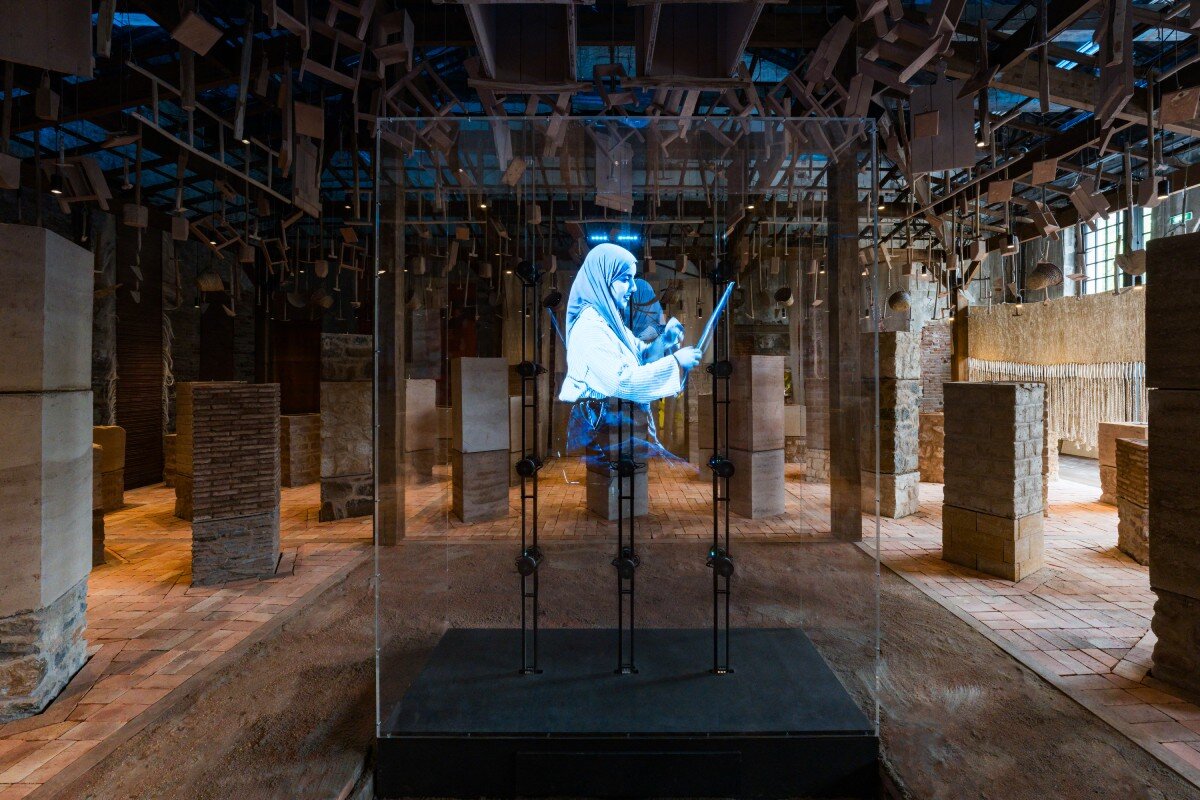
all images by Venice Documentation Project — Samuele Cherubini, courtesy of the Pavilion of the Kingdom of Morocco
celebrating material intelligence at venice architecture biennale
Materiae Palimpsest resonates in light of Morocco’s devastating 2023 earthquake. In rebuilding affected rural settlements, Khalil Morad El Ghilali’s practice, and others like it, have demonstrated how heritage-based techniques can perform better than concrete in these particular contexts. The architect points out that some of his team’s pilot structures near the epicentre remained undamaged, owing to a combination of local craftsmanship and adapted engineering, rooted in generational know-how. This extends El Ghilali’s approach that is driven by the urgency to reframe ancestral methods as scalable, adaptive, and technically sound alternatives to industrial construction. ‘Instead of abstract concepts, we aim to improve local crafts through practical upgrades in engineering and architecture, without losing sight of what people can really do at a large scale,’ he shares. El Mehdi Belyasmine adds: ‘Working with the land — using local soil, traditional tools, and ancestral know-how — allows us to reconnect with our heritage while also empowering local labor and craft. It’s not nostalgia — it’s continuity. It’s about building with intention, with care, and with respect for the people and the place.’
This philosophy grounds the pavilion in a clear critique of contemporary architectural education and practice, which, the duo notes, often privileges conceptual gestures over material literacy. Calls for a broader reflection on how architectural knowledge is produced, as El Ghalili reflects: ‘Too often today, architects don’t know how to build with their hands. They’re trained to be conceptual rather than constructive.’ He frames revisiting these embodied modes of making is as a return to a collaborative, ground-up process that brings designers back into conversation with materials, with place, and with the people who build, as emphasized by the flickering hologram figure at the center of the space, and the traces of the human hand it confronts as carried in each of the columns. Read our full interview with the architects and co-curators below.
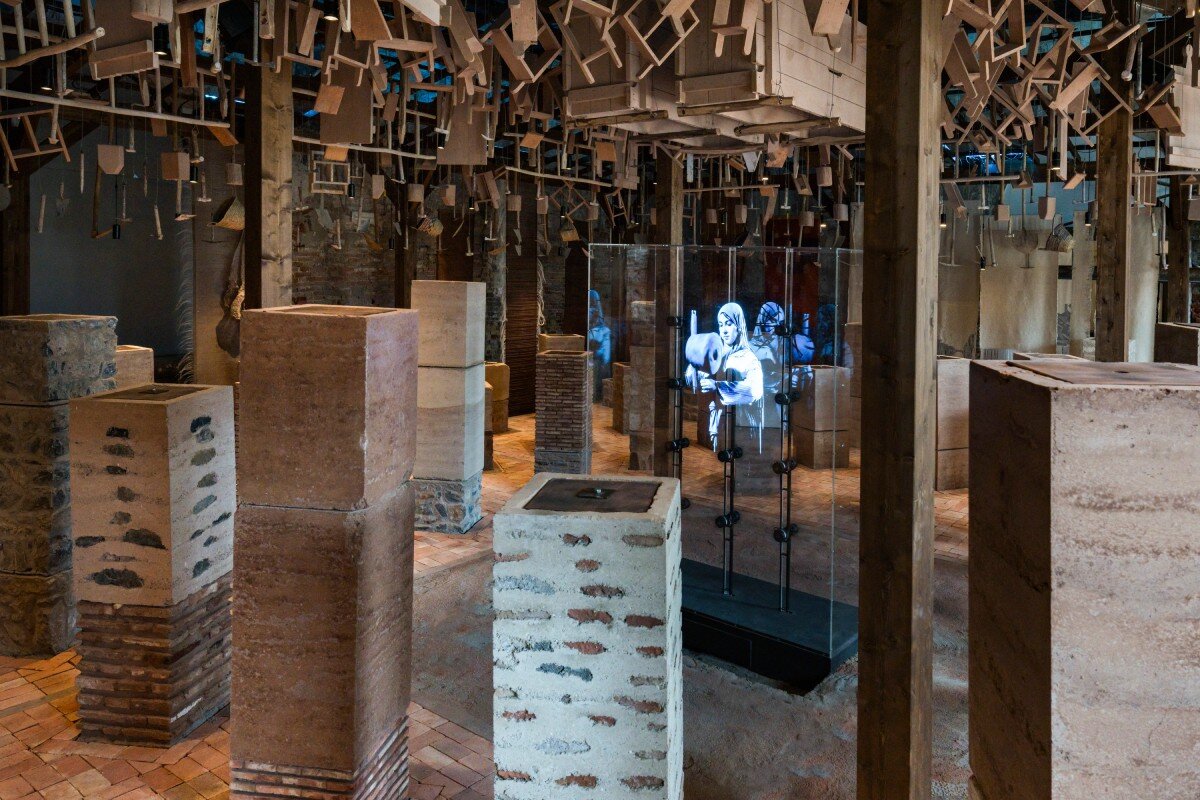
Materiae Palimpsest addresses challenges posed by earthquakes across the region
interview with Khalil Morad El Ghilali & El Mehdi Belyasmine
designboom (DB): Can you introduce the idea behind the creation of the pavilion?
Khalil Morad El Ghilali (KMEG): The idea was to sublimate the materiality and showcase the diversity of local construction techniques across Morocco. We’ve been gathering around 136 completely different techniques and materialities from all around the country — from the north to the south — that we’ve here integrated into 72 columns. These columns serve as a kind of guide for construction, particularly for architects interested in sustainable development.
This pavilion is one of our latest experiments: we used post-tensioned, prefabricated blocks as a potential solution for rebuilding in earthquake-affected areas. The entire pavilion was also assembled in three days. The blocks are solid, not hollow, and actually the heaviest one weighs 500 kilograms, and yet they were mounted like Lego pieces.
El Mehdi Belyasmine (EMB): The Moroccan Pavilion is conceived as an experimental space to deepen the understanding of cultural identity and highlight the significance of spatial performance — through visual aesthetics, scents, textures, and tactile sensations — creating an immersive and authentic experience within a dynamic environment. This approach should be implemented in all architectural projects. It is essential to design with a strong connection to the local context and its surroundings, recognizing these conditions as foundational architectural elements.
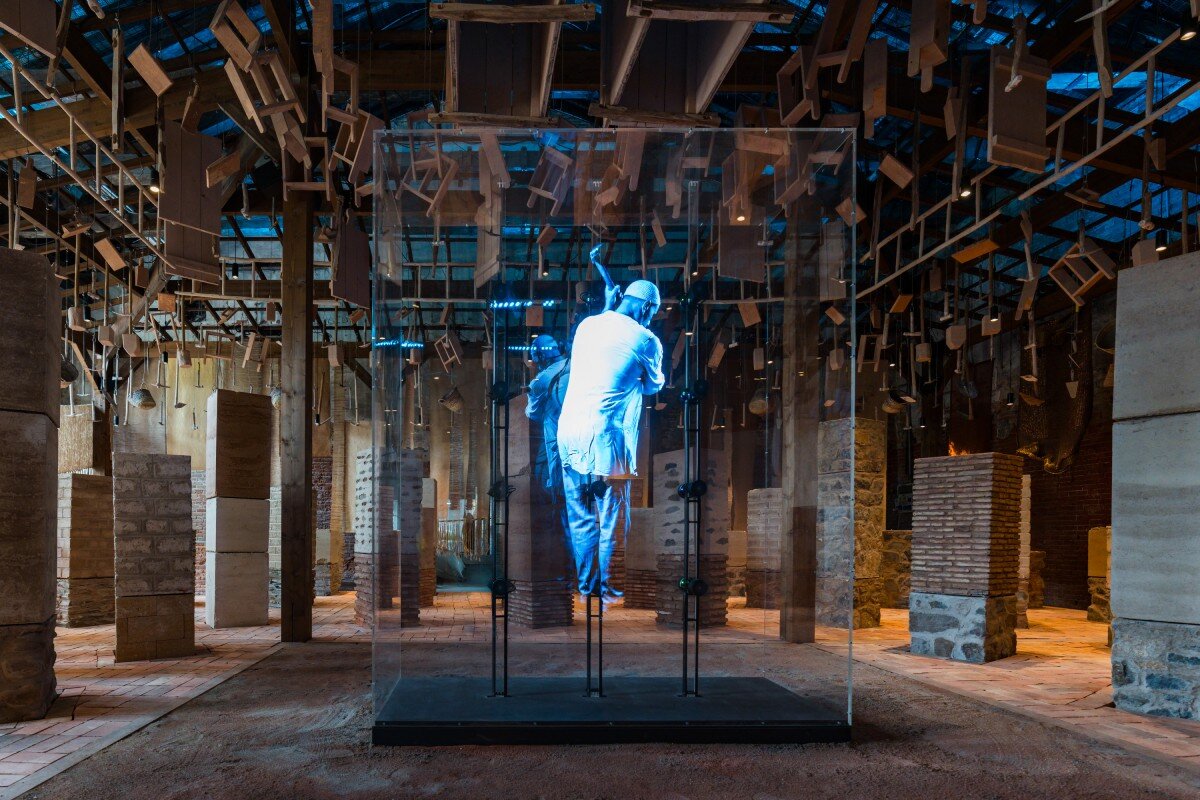
A hologram sits at the center of the space, representing the human condition and ancestral knowledge
DB: There are many layers to the scenography, from the almost ruins-like landscape of columns, to the textiles and the screen at the center. Can you share more about that?
KMEG: We’ve divided the scenography into three main elements.
The first is the columns, which reflect building, engineering, and architecture. The second is the tools. These are represented by the muqarnas hanging from the ceiling, which were historically used to construct such elements. We sourced them from different villages, and each tool carries the trace of a human hand and an imprint of collective engineering. The third element is the human condition, represented by a hologram. It’s intentionally fragile and immaterial, confronting the physical nature of the materials around it.
EMB: I wanted to create a space that pushes the boundaries of how we understand and express cultural identity. It’s an experimental platform that explores spatial performance — not just through form and function, but through texture, scent, sound, and atmosphere. Architecture should be felt, not just seen.
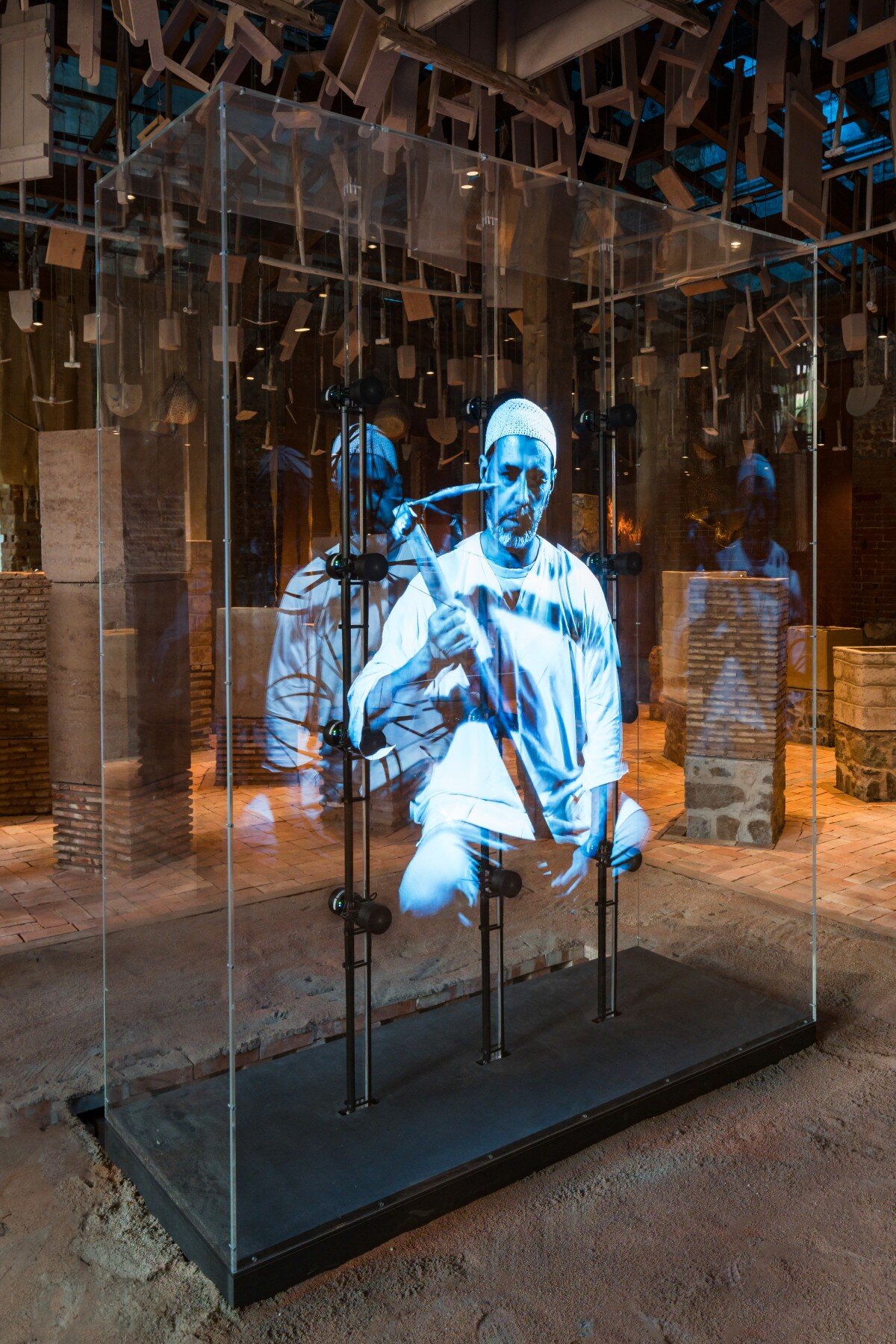
the pavilion takes an elemental approach to material, memory, and seismic resilience
DB: The presence of the hologram was quite unexpected after walking through all these tactile details. What role does it play within the overall composition?
KMEG: It raises a question about whether we should keep chasing extraordinary technologies to solve our problems, or whether we should instead ask what we can learn from our ancestors — not archaeologically, but humbly. There’s a vast body of knowledge gathered over thousands of years, and this project is about reconnecting with that wisdom rather than erasing it and starting from scratch.
So for us, this pavilion becomes a place of knowledge, collective intelligence, scent, fabric, texture, memory. Like a foyer, a place to gather. It reflects how Moroccans welcome people, how spaces are warm and inviting. Each brick, each tool, each trace carries human intelligence. Confronting these elements — between the artificial and the natural — was very important to us and the main idea of the pavilion.

